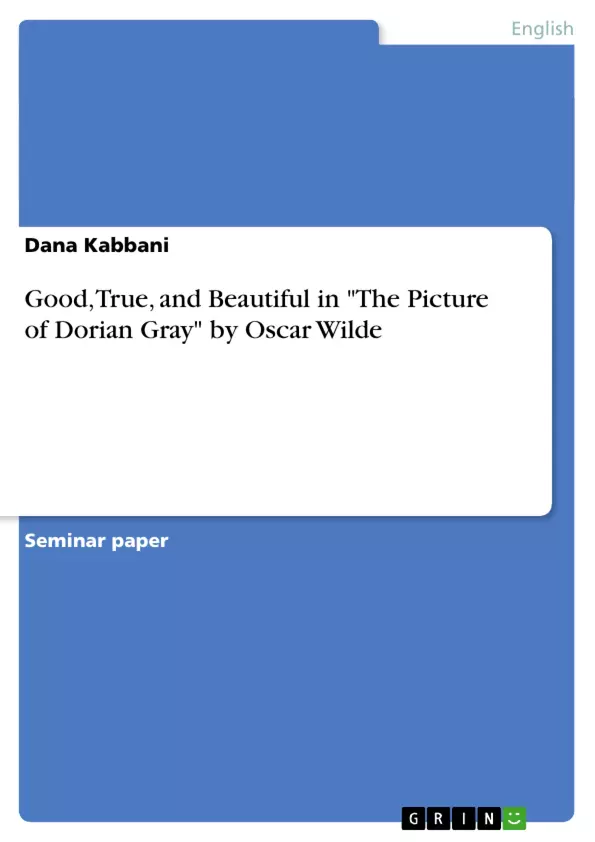1. Introduction:
In the following, the notions of “good, true, and beautiful” in Oscar Wilde’s The Picture of Dorian Gray will be examined, both separately and as they relate to one another. These adjectives carry a positive meaning, and they create a distinct contrast to the critiques and accusations that have been raised against the book and its writer. The Picture of Dorian Gray is in many ways a “pivotal work” (Lawler 285) in Oscar Wilde’s life and career. It sums up his major influences of the 1870s and 1880s, and anticipates the style of his celebrated comedies to come.
Why was the public’s opinion, which meant his ruin in the end, so important to Oscar Wilde? To answer this question it is necessary to look at Wilde’s audience and environment. Wilde was “the epitome of a new type of professional writer” (Small 3). Thus The Picture of Dorian Gray and the scandal it provoked have to be situated in the context of late Victorian social institutions of journalism, advertising, homosexual communities, criminology, etiquette, and theater (Gagnier, Cambridge Companion 27). Wilde had always been a great borrower and collector of literary culture, and therefore was often accused of plagiarism, but he transformed everything into his own way of expression. It is the blending of original invention and existing art that enables Wilde to create new effects and moods. This blending helps to explain how The Picture of Dorian Gray embraces the range from classic Greek and Latin masters to contemporary English, French, and German writers. From its first appearance in the spring of 1890, The Picture of Dorian Gray has suggested to readers parallels to other works, ancient or modern, in English or any other language.
To specify the focus, the novel can be regarded as a study of various Victorian art movements corresponding to different stages in the development of Victorian human nature, and the main characters are meant to be personifications of these art movements and psychological states (Nassaar 37). This paper tries to shed light not only on Wilde’s paradoxical style, but also on the 1890s society by answering the following questions: Which are the major art movements at the end of the 19th century; how far do they affect Wilde’s work? To what extent is the book good, true, and beautiful? Or are the opposites more appropriate?
[...]
Inhaltsverzeichnis (Table of Contents)
- Introduction
- Fin de Sciècle and Late 19th Century Art Movements
- Aestheticism
- Decadence
- Symbolism
- "Good"
- "True"
- "Beautiful"
- Fascination
- The Notion of Trinity
- Conclusion
Zielsetzung und Themenschwerpunkte (Objectives and Key Themes)
This paper aims to analyze the notions of “good, true, and beautiful” in Oscar Wilde's The Picture of Dorian Gray, both separately and in their interconnectedness. These adjectives evoke a positive meaning and provide a stark contrast to the criticisms and accusations levelled against the novel and its author. The paper further examines the influence of late 19th-century art movements on Wilde's work, particularly within the context of Victorian society.
- The significance of the adjectives "good, true, and beautiful" in Wilde's work
- The impact of fin de siècle art movements on The Picture of Dorian Gray
- The role of Victorian societal norms and institutions in shaping Wilde's writing
- The connection between the novel and contemporary art movements
- The relationship between the novel and Victorian social institutions
Zusammenfassung der Kapitel (Chapter Summaries)
The introduction sets the stage by highlighting the significance of "good, true, and beautiful" in understanding Wilde's work and the broader context of Victorian society. The following chapter delves into the late 19th-century art movements, including Aestheticism, Decadence, and Symbolism, that shaped the fin de siècle. The chapter explores how these movements influenced Wilde's artistic sensibilities and contributed to the novel's unique style.
The subsequent chapters delve into the individual themes of "good," "true," and "beautiful" within the novel, examining their complex nuances and the ways they interact with each other. These chapters delve into aspects like the portrayal of good and bad, the role of the portrait as a symbol, and the exploration of hidden homosexuality in Victorian society. The exploration of these themes provides insight into the novel's central concerns and Wilde's engagement with Victorian moral and social anxieties.
Further chapters focus on the concept of fascination and the role of the Trinity in Wilde's work, exploring how these concepts contribute to the novel's unique aesthetic and thematic depth.
Schlüsselwörter (Keywords)
Key themes and concepts explored in this paper include fin de siècle, Aestheticism, Decadence, Symbolism, "good, true, and beautiful," Victorian society, art movements, The Picture of Dorian Gray, Oscar Wilde, fascination, and Trinity. The paper delves into the relationship between these concepts and explores their significance within the context of late 19th-century literature and social commentary.
- Arbeit zitieren
- Dana Kabbani (Autor:in), 1998, Good, True, and Beautiful in "The Picture of Dorian Gray" by Oscar Wilde, München, GRIN Verlag, https://www.grin.com/document/7568



